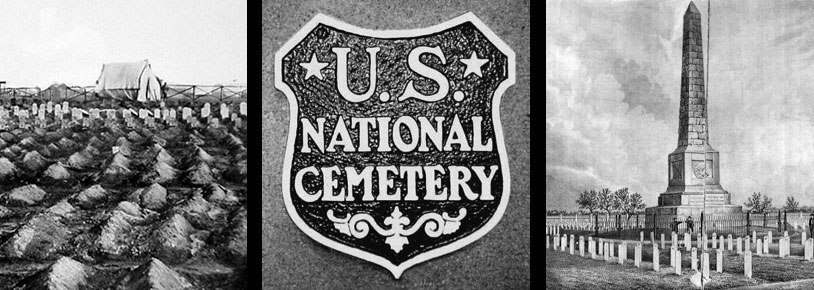

Civil War Era National Cemeteries: Honoring Those Who Served
Fort Leavenworth National Cemetery
Leavenworth, Kansas
 |
Leavenworth Monument Courtesy of the Department of Veterans Affairs, National Cemetery Administration, History Program |
In 1827, Brigadier General Leavenworth received orders to establish a garrison to protect the important trade routes that passed through the American Indian lands of present day Kansas. He selected a site on the east bank of the Missouri River, through which both the Oregon and Santa Fe Trails passed. The fort provided supplies to travelers, protected settlers, calmed American Indian uprisings, and suppressed skirmishes between abolitionists and pro-slavery forces. Eventually the fort became the western Army Headquarters, and served as the Kansas Territorial Capital from 1854 to 1861. In 1874, Fort Leavenworth became the site of the United States Disciplinary Barracks, one of the only military penitentiaries holding maximum-security prisoners. In 1881, General William Tecumseh Sherman founded the School of Application for Cavalry and Infantry at Fort Leavenworth, now the renowned Army Command and General Staff College.
During the Civil War, the fort served as an important training center for Union troops. Confederate General Sterling Price tried to capture the fort and its arsenal because of its strategic location. However, Union General Samuel Curtis defeated Price at the Battle of Westport, near Kansas City, in one of the largest battles west of the Mississippi River. Over 30,000 troops fought in this “Gettysburg of the West.”
The first burials at Fort Leavenworth date to 1827 and originally occurred in two separate cemeteries on site, one for enlisted soldiers and one for officers. In 1858, a new cemetery was established, and remains from the original cemeteries were reinterred here. In 1862, the cemetery was designated as one of the first 14 national cemeteries established across the country. Fort Leavenworth National Cemetery, then 5.5 acres, was the largest of the cemeteries. Today, it encompasses over 36 acres.
 |
Superintendent's Lodge Courtesy of the Department of Veterans Affairs, National Cemetery Administration, History Program |
Located near the original main entrance is the cemetery superintendent’s lodge, a two-story brick house with exposed stone foundation and a mansard roof. The cemetery’s first lodge was a simple wooden cottage just outside the cemetery grounds, but in 1874, a Second Empire-style lodge that Quartermaster General Montgomery C. Meigs designed replaced the earlier lodge. A 1904 fire destroyed the older lodge. The existing lodge dates from 1875, the year after the fire. Today, this lodge serves as the administrative office for the cemetery. Other buildings on site include a utility building that was once a stable, and a committal shelter erected in 2004.
1893 Site Plan of Fort Leavenworth National Cemetery. |
Another prominent private marker is an eight-foot tall granite memorial marking the grave of Colonel Edward Hatch. Hatch was the leader of a cavalry regiment that destroyed a vital rail link between Columbus and Macon, Georgia, while Grant led his assault against Vicksburg. Later he served in Sherman’s cavalry, leading a division that closely watched and delayed Confederate General John B. Hood’s Army of Tennessee, earning this unit the moniker “Eye of the Army.” Hatch is buried in Section A, Grave 2204.
Seven Confederate soldiers, all prisoners of war, are buried in Section D.
Fort Leavenworth National Cemetery is the final resting place of eight recipients of the Medal of Honor, the nation’s highest military decoration, given for “conspicuous gallantry and intrepidity at the risk of his life above and beyond the call of duty.”
| Plan your visit |
Fort Leavenworth National Cemetery is located at 395 Biddle Blvd., in Fort Leavenworth, KS. The cemetery is open for visitation daily from dawn to dusk; the administrative office is open Monday-Friday from 8:00am to 4:30pm, and is closed Federal holidays except Memorial Day. For more information, please contact the cemetery office at 913-758-4105, or see the Department of Veterans Affairs website. While visiting, please be mindful that our national cemeteries are hallowed ground. Be respectful to all of our nation’s fallen soldiers and their families. Additional cemetery policies may be posted on site. Fort Leavenworth National Cemetery was photographed to the standards established by the National Park Service’s Historic American Landscapes Survey. |
